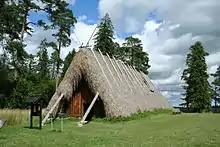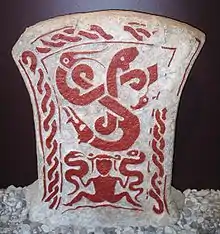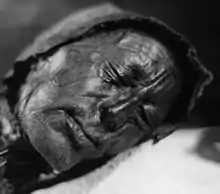Iron Age Scandinavia
Iron Age Scandinavia (or Nordic Iron Age) refers to the Iron Age, as it unfolded in Scandinavia.
.PNG.webp)
.png.webp)
Beginnings
The 6th and 5th centuries BC were a tipping point for exports and imports on the European continent. The ever-increasing conflicts and wars between the central European Celtic tribes and the Mediterranean cultures destabilized old major trade routes and networks between Scandinavia and the Mediterranean, eventually breaking them down, and changing the Scandinavian cultures dramatically. Now they had to be practically self-dependent and self-sustaining. Archaeology attests a rapid and deep change in the Scandinavian culture and way of life. Agricultural production became more intensified, organized around larger settlements and with a much more labour-intensive production. Slaves were introduced and deployed, something uncommon in the Nordic Bronze Age. The rising power, wealth and organization of the central European tribes in the following centuries did not seem to instigate an increased trade and contact between Scandinavia and central Europe before 200‒100 BC. At this point the Celtic tribes had organized themselves in numerous urban communities known as oppida, and the more stable political situation in Europe allowed for a whole new economic development and trade.[1]
Bronze could not be produced in Scandinavia, as tin was not a local natural resource, but with new techniques, iron production from bog iron (mostly in Denmark) slowly gained ground. Iron is a versatile metal and was suitable for tools and weapons, but it was not until the Viking Age that iron incited a revolution in ploughing. Previously, herds of livestock had pasture grazed freely in large wood pastures, but were now placed in stables, probably to utilize manure more efficiently and increase agricultural production. Even though the advent of the Iron Age in Scandinavia was a time of great crisis, the new agricultural expansions, techniques and organizations proceeded apace. And though the decline of foreign trade might suggest that the period marked a transition from a rich and wealthy culture to a poor and meagre one, the population grew and new technology was developed. The period might just reflect a change of culture and not necessarily a decline in standards of living.[1]
Periodization
The Iron Age in Scandinavia and Northern Europe begins around 500 BC with the Jastorf culture, and is taken to last until c. 800 AD and the beginning Viking Age. It succeeds the Nordic Bronze Age with the introduction of ferrous metallurgy by contact with the Hallstatt D/La Tène cultures.
- Pre-Roman Iron Age (5th to 1st centuries BC). There are many bog bodies from Danish bog areas, some ritually killed, perhaps as human sacrifices, of which Tollund Man (found 1950) is the best-known. Their hair, skin and possessions have often been preserved in the anaerobic conditions, allowing archaeologists to learn more about their lifestyle.[2]
- Roman Iron Age (1st to 4th centuries AD)
- Germanic Iron Age (5th to 8th centuries AD)
The Northern European Iron Age is the locus of Proto-Germanic culture, in its later stage differentiating into Proto-Norse (in Scandinavia), and West Germanic (Ingvaeonic, Irminonic, Istvaeonic) in northern Germany.
Archaeological findings
In February 2020, Secrets of the Ice Program researchers discovered a 1,500-year-old Viking arrowhead dating back to the Germanic Iron age and locked in a glacier in southern Norway caused by the climate change in the Jotunheimen Mountains. The arrowhead made of iron was revealed with its cracked wooden shaft and a feather, is 17 cm long and weighs just 28 grams.[3][4][5][6]
Culture and religion
| Nordic Iron Age culture | |
|---|---|
| |
| |
| |
| Nordic Iron Age cult | |
|---|---|
| |
| |
| |
References
- Jørgen Jensen: I begyndelsen
- "Ancient Europe 8000 B.C-1000 A.D" (PDF). Archived from the original (PDF) on 2016-01-09. Retrieved 2018-11-09.
- cowie, ashley. "Huge 1,500-Year-Old Arrowhead Released From Melting Glacier". www.ancient-origins.net. Retrieved 2020-03-25.
- Bailey, Stephanie. "Climate change reveals, and threatens, thawing relics". CNN. Retrieved 2020-03-25.
- Ramming, Audrey (2020-03-06). "Photo Friday: Norwegian Glacial Ice Preserves Ancient Viking Artifacts". GlacierHub. Retrieved 2020-03-25.
- "1,500-Year-Old Viking Arrowhead Found After Glacier Melts in Norway". Curiosmos. 2020-03-09. Retrieved 2020-03-25.
Sources
- Jørgen Jensen (2002): I begyndelsen, Gyldendal og Politikens Danmarks Historie (Vol. 1), ISBN 87-89068-26-2 (in Danish)
- Bente Magnus, G Franceschi, Asger Jorn (2005): Men, Gods and Masks in Nordic Iron Age Art. OCLC 84747032.
- M Zvelebil (1985): Iron Age transformations in Northern Russia and the Northeast Baltic, Beyond Domestication in Prehistoric Europe
External links
 Media related to Nordic Iron Age at Wikimedia Commons
Media related to Nordic Iron Age at Wikimedia Commons














_2747.jpg.webp)

_sid_295).jpg.webp)

_gravklot-kopia_5209.jpg.webp)
